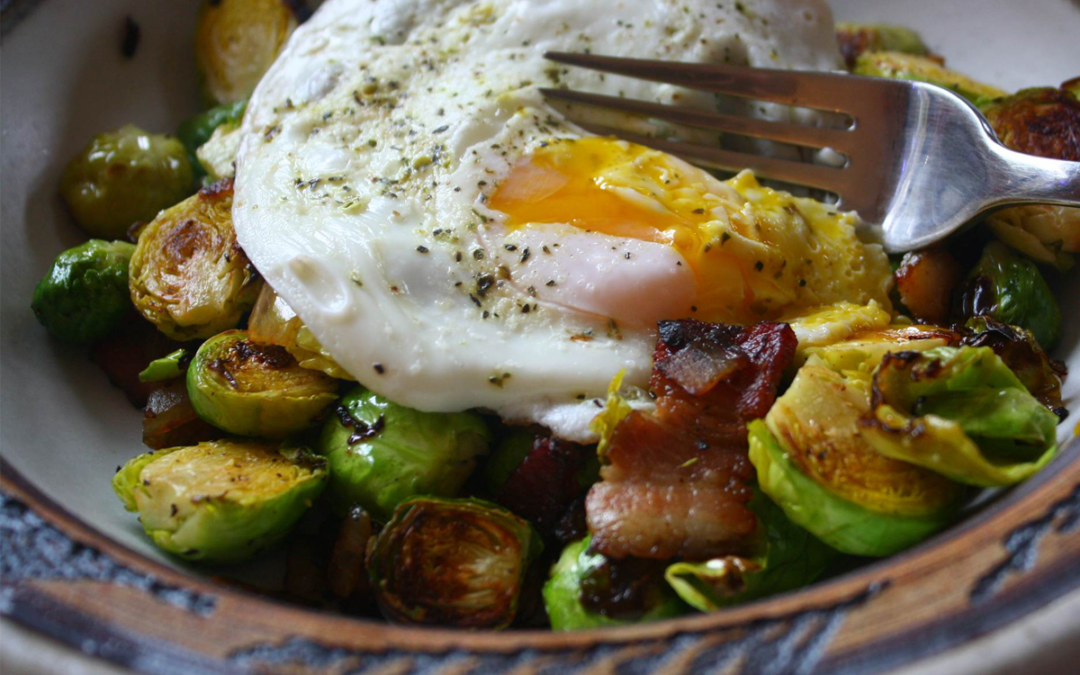“We kids feared many things in those days – werewolves, dentists, North Koreans, Sunday School – but they all paled in comparison with Brussels sprouts.” Dave Barry
Brussel sprouts have about as clouded of a history as they do a reputation but it is a widely accepted that they were cultivated from the great mother cabbage. In fact, all brassicas, like broccoli, kale, kohlrabi, and cauliflower are descendants from the venerable cabbage.
People took the cabbage and bred it into umpteen million different kinds of leafy greens and brassicas. You see, the cabbage used to be very important crop to the world due to its high nutritional content, great winter storage and its ability to grow in crappy soil and weird, cold conditions. For many years, in many places, the cabbage is what kept the human race going nutritionally. It is not a coincidence that just about every culture in the world has a recipe for some sort of pickled cabbage, you know like sauerkraut, kim chee, suan cai, etc.
Somewhere around the 5th, 13th, 15th 17th or 18th century, Brussels sprouts were birthed in Northern Europe, most likely in Brussels. No one really knows. It is figured that they were cultivated to avoid freezing like regular cabbages do in the Northern climates. Their small buds on a stock grow faster and so get harvested quicker. They are basically a fast growing “mini me” of the cabbage.
This cruciferous vegetable contains 2-3 times the amount of phytonutrients called glucosinolates than are found in any other brassica. This chemical boosts DNA repair in cells and appears to block the growth of cancer cells. (It is interesting to note that Brussels sprouts grow in a double helix pattern like DNA.) And that is a reason to love Brussels sprouts.
The reason to hate them is that there is another beneficial cancer blocking chemical, phenylthiocarbamide (PTC), which is either bitter or tasteless depending on one’s genetic makeup. This gene has been linked back to our Neanderthal ancestors who were wired with this gene that “bitter equals poison.” Oddly enough, Homo sapiens with no Neanderthal genes in them do not taste PTC, so if Brussels sprouts taste bad to you, you have caveman genes. Now you know.
There are some ways to make sure Brussels sprouts taste good no matter what your gene pool is. First, make sure that they are very fresh. Brussels sprouts grow on stocks and sometimes you will find them artfully so at a grocery store. This is the way to buy them if possible because they are most likely fresh. If they are sold loose, inspect them carefully to see if they are dry or have yellow or discolored leaves. That is a sign they are fairly old and will taste stronger in the undesirable flavor. Also look for dense, heavy sprouts that are tightly compacted to determine the best ones to enjoy.
Second, it is very important how you cook them. Do not boil them as you will lose many of their dynamite nutrients and they taste awful. Cooking them by dry heat methods like roasting, sautéing, and even grilling is best. Water leeches flavor as well as nutrients and cannot produce the intensity of flavor that dry heat methods can. Whatever way you cook them, DO NOT OVERCOOK THEM!! That is the sure fire way to kill Brussels sprouts and give your children nightmares.
Indisputably, Brussels sprouts are most sumptuous when combined with a rich pork product like bacon, prosciutto or pancetta. (What isn’t better with bacon??) This basic recipe that I am humbly offering up here is the perfect way to cook them. (And it is easy too!) I have included many variations on the theme which a few include bacon, of course. Just don’t overcook them or you will hate them whatever your genes pool is.
Basic Roasted Brussels Sprouts (even a caveman would like)
1 1/2 pounds of Brussels sprouts
2-3 tablespoons of olive oil
3/4 teaspoon of salt
1/2 teaspoon of ground pepper
Sprinkle of red pepper flakes (Optional)
Preheat your campfire (oven) to 400 degrees. Prepare your Brussels sprouts by peeling off the ends and any yellow outer leaves then cutting them into halves. Place them into a bowl and toss them with the olive oil, salt and pepper. Then pour them out into a baking dish and spread them out to a single layer. Roast for 20-30 minutes, on the top shelf of the oven, stirring once during the baking time. You know they are done when they are just getting tender but still bright green in color. Taste and adjust the salt and pepper then serve immediately. (Some people swear by a little extra salt on them)
Variations
Bacon roasted Brussels sprouts
Before you roast the Brussels sprouts, cut up 2-3 pieces of thick center cut bacon into matchsticks and sauté in a heavy skillet then pour bacon grease and bacon pieces on the Brussels sprouts in the bowl and toss with salt and pepper. (if they seem a bit dry add a tablespoon of olive oil) Roast 20-30 minutes, on the top shelf of the oven till done.
Bacon walnut cranberry roasted Brussels sprouts
Do the same technique as above but add 1/2 cup of chopped raw walnuts with the bacon and sauté together. Roast like the basic recipe. After the Brussels sprouts have roasted, toss ½ cup of dried cranberries with the sprouts.
Garlic roasted parmesan Brussels sprouts
Do the same technique as the basic roasted Brussels sprouts but add three to four cloves of minced garlic to the sprouts when you toss them with the olive oil. Roast as directed in the basic recipe except half way through the roasting when you stir them, sprinkle them with 2-4 tablespoons of grated parmesan cheese. Continue to roast till done.
– Dana Zia

